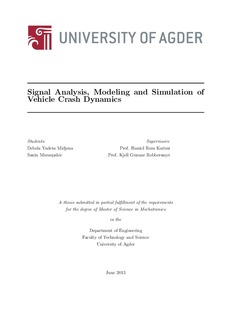Signal analysis, modeling and simulation of vehicle crash dynamics
Abstract
Vehicle crash safety has been a strong point of interest for long time in many countries due to
the reason that safety statistics show high fatality rate of vehicle occupants involved in road
accidents. All vehicles which are going to appear on the road must go through several serious
crash investigations to approve whether they conform to the relevant safety standards. There are
large crash test facilities built by big companies for these operations. However, a wide and full-scale
crash testing is complex, di cult and expensive that demands many things to be ful lled. Because
of these and other reasons, mathematical models could be developed to represent real world vehicle
crash scenarios. This work is devoted to developing a vehicle crash modeling and a reconstruction
of physical models composed of springs, dampers and mass arrangements to simulate a real car
collision with a rigid pole. First, an extensive signal analysis is carried out to understand the vehicle
full-scale frontal crash in time domain and frequency domain. Next, 2D and 3D mass-springdamper
model are presented and equations of motion for the dynamic model are being established
and subsequently solutions to obtain di erential equations are formulated. The models' parameters
are obtained by tting their response equations to the real data measurement from vehicle crash
experiment. The identi ed parameters with the proposed 2D and 3D mathematical models are
used for the simulation, and the response from the models are veri ed by comparing them with
the real data from experiment. The comparison and validation show that the model represented
are well suited to the real vehicle crash scenario.
Description
Masteroppgave i mekatronikk MAS500 2013 – Universitetet i Agder, Grimstad
